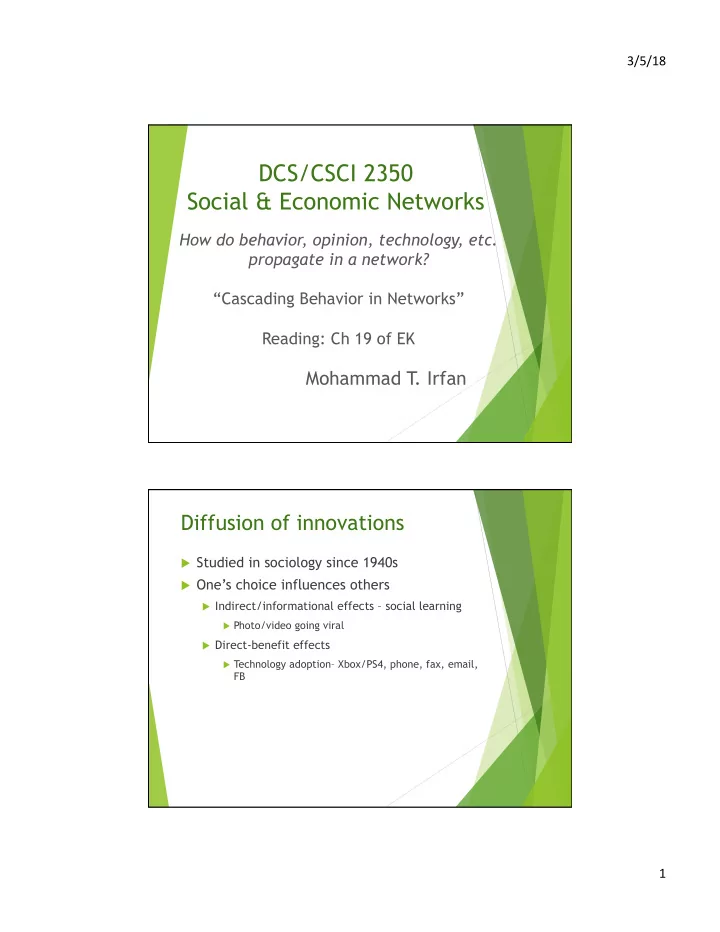

3/5/18 DCS/CSCI 2350 Social & Economic Networks How do behavior, opinion, technology, etc. propagate in a network? “Cascading Behavior in Networks” Reading: Ch 19 of EK Mohammad T . Irfan Diffusion of innovations u Studied in sociology since 1940s u One’s choice influences others u Indirect/informational effects – social learning u Photo/video going viral u Direct-benefit effects u Technology adoption– Xbox/PS4, phone, fax, email, FB 1
3/5/18 Examples u Adoption of hybrid seed corn in Iowa u Ryan and Gross, 1943 u Adoption of tetracycline by US doctors u Coleman, Katz, and Menzel, 1966 u Shared ingredients u Indirect effects u Adoption was high-risk, high-gain u Early adopters had higher socioeconomic status u Social structure was important– visibility of neighbors’ activity Success factors of diffusion u Diffusion of Innovations – Everett Rogers (1995) u Complexity u Observability u Trialability u Compatibility 2
3/5/18 #TheDress (February 2015) 3
3/5/18 Next u Modeling diffusion u Connection with the things we know u Homophily u Clustering u The strength of weak ties 4
3/5/18 Threshold models for diffusion Precursor– Granovetter's model u Mark Granovetter's threshold model of collective behavior (1978) u Side note: collective behavior vs. collective action u Model: An individual will adopt action A if at least a certain number (threshold) of other individuals adopt A 5
3/5/18 Granovetter's model u Example u Emergence of a riot in a crowd of 100 people (complete graph) u Thresholds of individuals to get violent u 0, 1, 2, ..., 99 Extremely important that u What will happen? someone has a threshold u Extensions of 0. Why? u General network u Distribution of thresholds u Difference with Schelling's model: In Granovetter's model, slight change of thresholds may lead to completely different global outcome. Contagion Model Stephen Morris, 2000 6
3/5/18 Initial adopters u Facilitates diffusion u Granovetter's model: the persons with threshold = 0 are the initial adopters vs. We can set initial adopters without any regard for their threshold u Modeling assumption by Kleinberg & many others Example: switching from B to A u Initially everyone does B u Payoff parameters: b = 2, a = 3 u Threshold for switching from B to A, q = 2/5 u We will set two initial adopters of A and "play out" the diffusion 7
3/5/18 Complete cascade u Def. A set of initial adopters causes a "complete cascade" if everyone adopts the new action at the end of diffusion. u Always happens? 8
3/5/18 What are the factors for a widespread diffusion? u Initial adopters u Network structure u Threshold value q u Quality of product– payoff parameters a and b u Example: viral marketing 9
3/5/18 Diffusion vs. strength of weak ties u Weak ties are conveyors of information u But cannot “force” adoption of behavior Would Align with own community Diffusion vs. clustering u Does clustering help diffusion? Every node in these clusters have at most 1/3 fraction of friends outside. Will they ever adopt the new behavior? 10
3/5/18 More general models Influence games (Irfan, 2013) u Thresholds are heterogeneous u Directed, asymmetric network u Relationships can be positive or negative (gradation of "influence" is also allowed) u Switching back and forth two actions are allowed u Initial adopters (I.A.) Granovetter: Kleinberg: I.A. must have I.A. can be externally threshold 0 set (their thresholds don't matter) What can go wrong? We: I.A. can be externally set as long as their threshold requirements are fulfilled at the end of diffusion 11
3/5/18 Linear threshold model u Model parameters u Threshold of each node u Influence level from one node to another u Want to know: What will they do? Model 6 4 2 0 -2 Nay/-1 -4 Yea/+1 -6 +5 +2 Johnson (R, WI) Paul (R, KY) -2 -3 DeMint (R, SC) He will vote: Nay/-1 Yea/+1 Yea/+1 Schumer (D, NY) Sanders (I, VT) 12
3/5/18 Other applications 6 4 2 0 -2 -4 -6 +5 +2 +2 +3 Smoke or not? Application to Senate 13
3/5/18 110 th Congress 2007-09 Who are the most influential senators? 1. Machine learning 2. Compute all possible outcomes 3. Find the most influential nodes 110 th Congress 2007-09 Who are the most influential senators? 14
3/5/18 112 th Congress 2011-13 112 th Congress 2011-13 Who are the most influential senators? 15
3/5/18 Pointers u Main reading: Ch 19 of EK u Granovetter’s threshold model u http://vserver1.cscs.lsa.umich.edu/~spage/ ONLINECOURSE/R2Granovetter.pdf u Collective action u My dissertation u http://www.bowdoin.edu/~mirfan/papers/ Mohammad_Tanvir_Irfan_Dissertation.pdf u Section 2.1.1 and Appendix 2A u External links u Gladwell’s view: http://www.youtube.com/watch?v=YFbkVL1X9M8 u Watts’ view: http://www.fastcompany.com/641124/tipping-point- toast 16
Recommend
More recommend